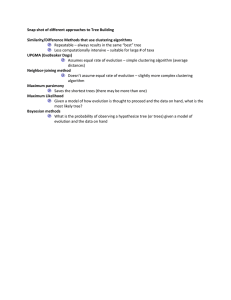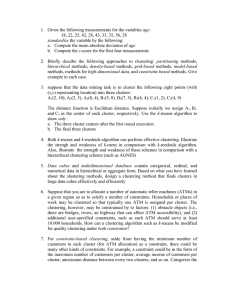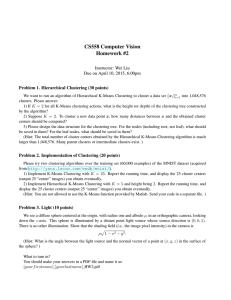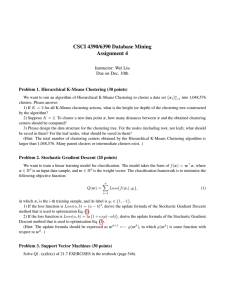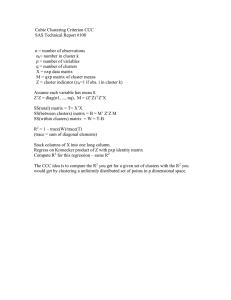Slides - New York University
advertisement
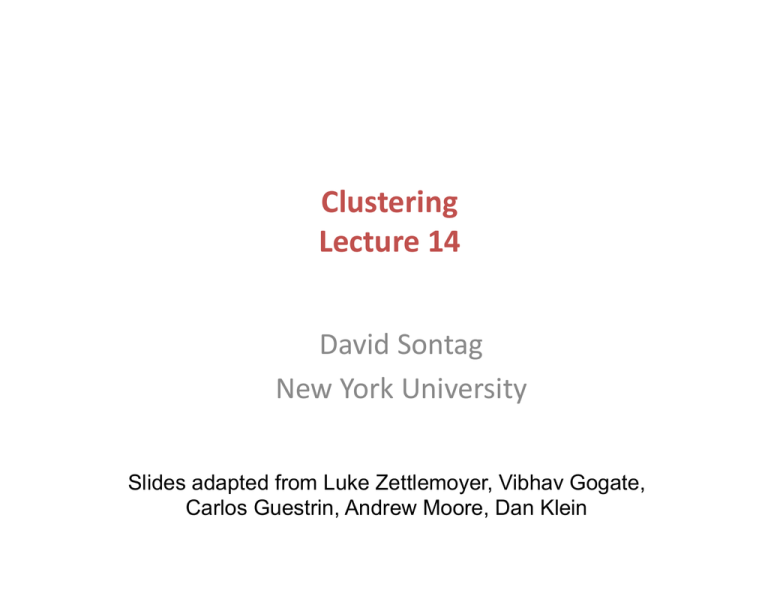
Clustering Lecture 14 David Sontag New York University Slides adapted from Luke Zettlemoyer, Vibhav Gogate,
Carlos Guestrin, Andrew Moore, Dan Klein
Clustering
Clustering:
– Unsupervised learning
– Requires data, but no labels
– Detect patterns e.g. in
• Group emails or search results
• Customer shopping patterns
• Regions of images
– Useful when don’t know what
you’re looking for
– But: can get gibberish
Clustering
• Basic idea: group together similar instances
• Example: 2D point patterns
Clustering
• Basic idea: group together similar instances
• Example: 2D point patterns
Clustering
• Basic idea: group together similar instances
• Example: 2D point patterns
• What could similar mean?
– One option: small Euclidean distance (squared)
dist(�x, �y ) = ||�x − �y ||22
– Clustering results are crucially dependent on the measure of
similarity (or distance) between “points” to be clustered
• /(&'+'0-(0+"+"*,'(%-.$
– 1,%%,.#23 +**",.&'+%(4&
– 5,26,7)3 6(4($(4&
Clustering algorithms
• 8+'%(%(,)+"*,'(%-.$9:"+%;
– <Ͳ.&+)$
– =(>%#'&,?@+#$$(+)
– A2&0%'+"!"#$%&'()*
!"#$%&'()*+"*,'(%-.$
• /(&'+'0-(0+"+"*,'(%-.$
– 1,%%,.#23 +**",.&'+%(4&
– 5,26,7)3 6(4($(4&
• 8+'%(%(,)+"*,'(%-.$9:"+%;
– <Ͳ.&+)$
Clustering examples
Image segmenta3on Goal: Break up the image into meaningful or perceptually similar regions [Slide from James Hayes]
Clustering examples
Clustering gene
expression data
Eisen et al, PNAS 1998
9
K-Means
• An iterative clustering
algorithm
– Initialize: Pick K random
points as cluster centers
– Alternate:
1. Assign data points to
closest cluster center
2. Change the cluster
center to the average
of its assigned points
– Stop when no points
assignments change
K-Means
• An iterative clustering
algorithm
– Initialize: Pick K random
points as cluster centers
– Alternate:
1. Assign data points to
closest cluster center
2. Change the cluster
center to the average
of its assigned points
– Stop when no points
assignments change
K-­‐means clustering: Example • Pick K random
points as cluster
centers (means)
Shown here for K=2
11
K-­‐means clustering: Example Iterative Step 1
• Assign data points to
closest cluster center
12
K-­‐means clustering: Example Iterative Step 2
• Change the cluster
center to the average of
the assigned points
13
K-­‐means clustering: Example • Repeat unDl convergence 14
K-­‐means clustering: Example 15
K-­‐means clustering: Example 16
K-­‐means clustering: Example 17
ProperDes of K-­‐means algorithm • Guaranteed to converge in a finite number of iteraDons • Running Dme per iteraDon: 1. Assign data points to closest cluster center
O(KN) time
2. Change the cluster center to the average of its
assigned points
O(N) What properDes should a distance !"#$%&'%(&$)(**"'+,-#-)*$#./(
measure have? 0(#*+&("#1(2
• 3400($&)/
– 56789:;56987:
– <$"(&=)*(8=(/#.*#47,''>*,)>(9?+$9-'(*.'$,''>
,)>(7
• @'*)$)1)$48#.-*(,AͲ*)0),#&)$4
– 56789:B8#.-56789:;B)AA 7;9
– <$"(&=)*($"(&(=),,-)AA(&(.$'?C(/$*$"#$=(/#..'$$(,,
#%#&$
• D&)#.E,().(F+#,)$4
– 56789:G5698H: 5678H:
– <$"(&=)*('.(/#.*#4I7)*,)>(989)*,)>(H8?+$7)*.'$
,)>(H#$#,,J
[Slide from Alan Fern]
!"#$%& '(%)#*+#%,#
!"#$%&'($
σୀଵ σ௫א ݔെ ߤ
ఓ
-. /01ߤ2(340"05#!"
!"#$%&'()#*+,
ݔെ ߤ
ଶ
ୀଵ ௫א
ଶ
ൌ ݔ െ ߤ௫
ଶ
6. /01!#(340"05#ߤǣ
σୀଵ σ௫א ݔെ ߤ
ଶ
ఓ
– 7$8#3$*40$9:#*0)$40)#(;ߤ $%:&#44(5#*(2<#=$)#
ߤ ൌ
ͳ
ݔ
ȁܥ ȁ
௫א
!"#$-&'()#*+,
!"#$%& 4$8#&$%$94#*%$40%+(340"05$40(%$33*($,=2#$,=&4#30&+>$*$%4##:4(
:#,*#$&#4=#(?@#,40)#A 4=>&+>$*$%4##:4(,(%)#*+#
[Slide from Alan Fern]
Example: K-Means for Segmentation
K=2
K =2
Goal of Segmentation is
to partition an image
into regions each of
which has reasonably
homogenous visual
appearance.
K =3
K = 10
Original
Original image
Example: K-Means for Segmentation
K=2
K =2
K=3
K =3
K=10
K = 10
Original
Original image
Example: K-Means for Segmentation
K=2
K =2
K=3
K =3
K=10
K = 10
4%
8%
17%
Original
Original image
Example: Vector quantization
514
14. Unsupervised Learning
FIGURE 14.9. Sir Ronald A. Fisher (1890 − 1962) was one of the founders
of modern day statistics, to whom we owe maximum-likelihood, sufficiency, and
many other fundamental concepts. The image on the left is a 1024×1024 grayscale
image at 8 bits per pixel. The center image is the result of 2 × 2 block VQ, using
200 code vectors, with a compression rate of 1.9 bits/pixel. The right image uses
only four code vectors, with a compression rate of 0.50 bits/pixel
[Figure from Hastie et al. book]
We see that the procedure is successful at grouping together samples of
the same cancer. In fact, the two breast cancers in the second cluster were
Initialization
• K-means algorithm is a
heuristic
– Requires initial means
– It does matter what you pick!
– What can go wrong?
– Various schemes for preventing
this kind of thing: variance-based
split / merge, initialization
heuristics
K-Means Getting Stuck
A local optimum:
Would be better to have
one cluster here
… and two clusters here
K-means not able to properly cluster
Y
X
Changing the features (distance function)
can help
R
θ
Agglomerative Clustering
• Agglomerative clustering:
– First merge very similar instances
– Incrementally build larger clusters out
of smaller clusters
• Algorithm:
– Maintain a set of clusters
– Initially, each instance in its own
cluster
– Repeat:
• Pick the two closest clusters
• Merge them into a new cluster
• Stop when there s only one cluster left
• Produces not one clustering, but a
family of clusterings represented
by a dendrogram
Agglomerative Clustering
• How should we define closest for clusters
with multiple elements?
Agglomerative Clustering
• How should we define closest for clusters
with multiple elements?
• Many options:
– Closest pair
(single-link clustering)
– Farthest pair
(complete-link clustering)
– Average of all pairs
• Different choices create
different clustering behaviors
Agglomerative Clustering
• How should we define closest for clusters
with multiple elements?
Closest pair
Link Example
(single-linkSingle
clustering)
Farthest pair
(complete-link
clustering)
Complete
Link Example
1
2
5
6
1
2
5
6
3
4
7
8
3
4
7
8
[Pictures from Thorsten Joachims]
Clustering Behavior Average
Farthest
Nearest
Mouse tumor data from [Hastie et al.]
Agglomerative Clustering Questions
• Will agglomerative clustering converge?
– To a global optimum?
• Will it always find the true patterns in the data?
• Do people ever use it?
• How many clusters to pick?
Reconsidering “hard assignments”? • Clusters may overlap • Some clusters may be “wider” than others • Distances can be deceiving! Extra • K-­‐means Applets: – hOp://home.dei.polimi.it/maOeucc/Clustering/
tutorial_html/AppletKM.html – hOp://www.cs.washington.edu/research/
imagedatabase/demo/kmcluster/
